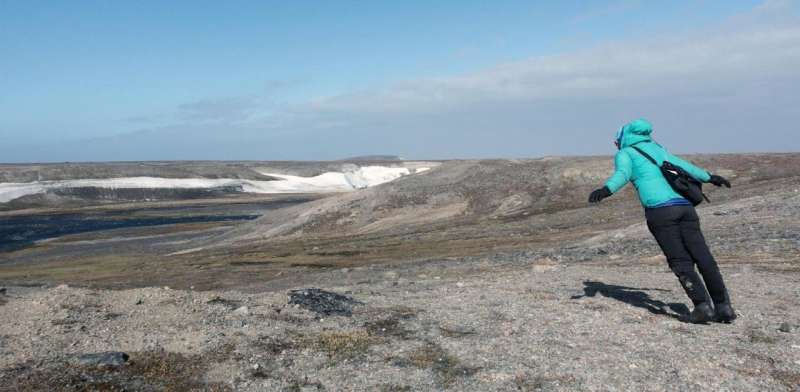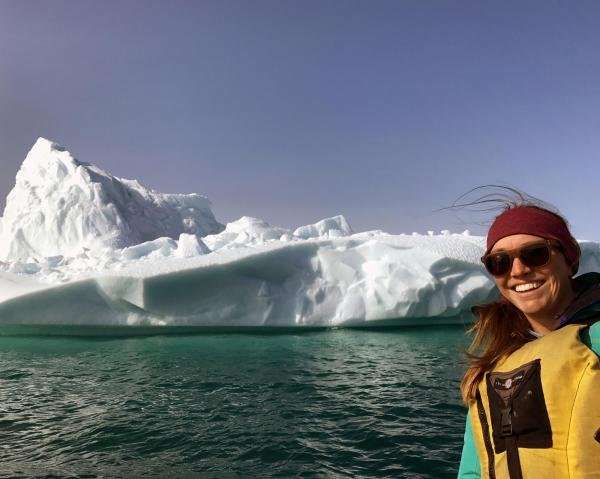Digging in the Arctic mud for answers to climate change

Working from a small boat on the choppy lake waters in northern Canada, Sarah Crump, a paleoclimatologist, pulls up a 5-foot mud core sample from the undisturbed lakebed. Crump and her research team work with a sense of urgency. Even in summer, bad weather can move in quickly. And they must always be vigilant for polar bears.
Known as the world's "climate change barometer," the Arctic, which includes Baffin Island, is classroom and laboratory for Crump, a PhD student in geological studies and a researcher with the Institute of Arctic and Alpine Research (INSTARR). With a focus on paleoclimate in the Arctic, she studies past climate change and how it affected glaciers and ecosystems on Baffin Island.
The rugged landscape on Baffin Island, the fifth-largest island in the world, features dramatic peaks, rolling tundra and glaciers. Crump, who has conducted fieldwork on Baffin Island five times, has seen polar bears, Arctic wolves, Arctic foxes, bowhead whales and seals. In mid-August, the sun sets only briefly, and even then it's not fully dark.
Chemical traces in the sediment cores provide a continuous record of activity that occurred around the lakes over thousands of years. By sequencing plant DNA directly from the sediment, Crump can determine what types of vegetation grew there through time. The information helps researchers understand how plant communities responded to previous climate change. The fact that the DNA is in the mud itself is what is so novel about the new technique.

"We're interested in learning and predicting what might happen in the Arctic as it warms up in modern times," she said. "We already know that shrubs are moving northward, but we don't know the rate or what that will look like. So, we're looking to the past to inform the future."
Collaboration among scientists from other disciplines provides Crump with opportunities to use new techniques to analyze the ancient sediment. Crump's advisor, Gifford Miller, an INSTAAR fellow and professor of geological sciences, has a colleague in Australia who introduced them to using ancient DNA from lake sediment, that, until recently, hadn't been widely used in paleoclimate studies. Borrowing techniques from molecular biologists, they can precisely identify the rates, magnitude and ecological effects of climate variability.
To re-create the climate story from ancient sediment records, Crump is working with Julio Sepulveda, INSTAAR fellow and professor of geological sciences, who built a state-of-the-art organic geochemistry lab in the Sustainability, Energy and Environment Community (SEEC) to analyze sediment samples for novel climate proxies, which are bacterial molecules that can reveal what the temperatures were centuries—and even millennia—ago.
"We get these beautiful snapshots of plant communities over time," Crump said. "Around 7,000 years ago on Baffin Island following the last glaciation, glaciers were retreating and it was warmer. We can see when certain plant species show up, including woody shrubs that were important to the ecosystem then. Everything we've found looks similar to Arctic ecosystems today."
While their research is not complete, the initial findings show a typical tundra ecosystem with dwarf shrubs, berries, aquatic vegetation and grasses.
"That lab is an amazing resource to have here [in the SEEC building]," Crump said. "What we're hoping to do is create a record of temperature and vegetation change that are synced to get a precise climatic context for ecosystem change. That wouldn't have been possible without this lab. There's so much cool, cross-pollination of ideas. I'm also working with the Bartlett Science Communication Center in SEEC on the filmmaking aspect of the season. A lot of good synergy is happening here for sure."
This was Crump's first trip leading a team to the Arctic, and she meticulously planned what equipment to take, since there's no hardware store to buy a forgotten item.
"Fieldwork has been a powerful experience for me," she said. "I've gained confidence and independence, trusting myself to get out there and figure things out. Getting into the field keeps me motivated. I'm lucky to work in such a special, important place. Connecting with the Inuit who live there keeps me focused on why we do this work."
Provided by University of Colorado at Boulder




















